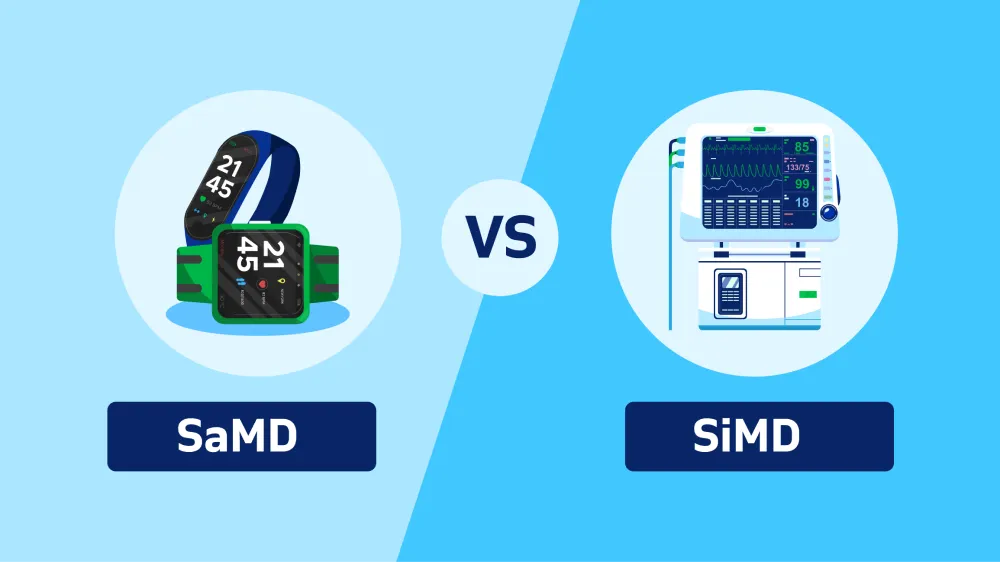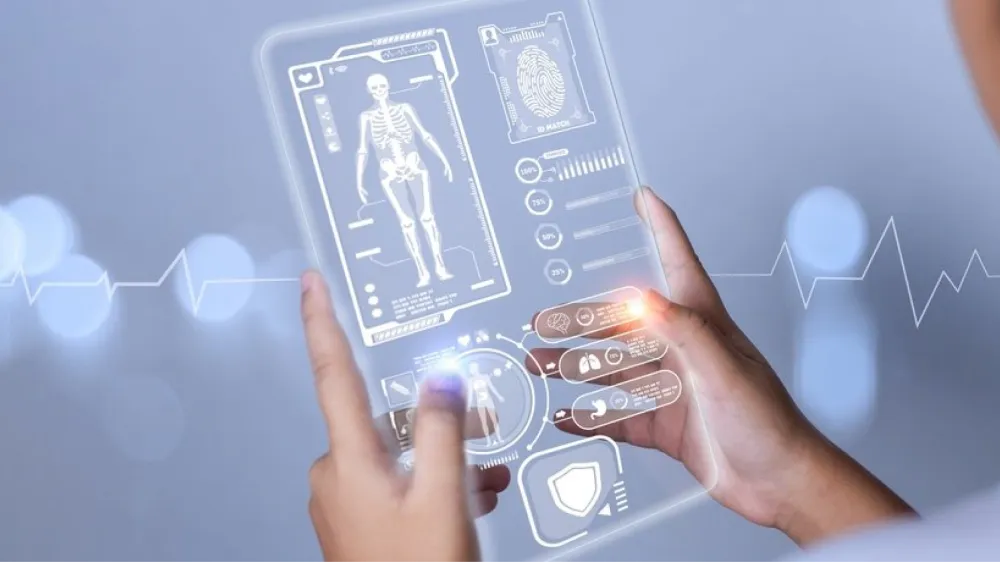Software as a Medical Device (SaMD) is carving out a future space as an emergent tech within healthcare facilities and care delivery services. According to the most recent studies, the worldwide SaMD market size was $1.4 billion in 2022 and is projected to grow at a CAGR of 40.05%, reaching $10.8 billion by 2028.
SaMD has been an essential part of many popular medical applications, including Magnetic Resonance Imaging (MRI) software and X-ray imaging software. However, many healthtech leaders still need clarification about its core functions, latent potential, and crucial role in the healthcare industry’s progress. This blog will explore critical considerations of SaMD, highlighting its rising importance, significant benefits, and widespread applications.
What is Software as a Medical Device?
Software as a Medical Device is software that performs one or various medical functions independently, without the need for integration into hardware devices.
In vitro diagnostic (IVD) medical devices, medical mobile apps, or desktop software are a few examples. The Software as a Medical Device can also run on smartphones, tablets, laptops, electronic devices, or whichever is most easily accessible to users to perform medical purposes like diagnosis, prevention, monitoring, and treatment of diseases and conditions.
SaMD utilizes different data inputs based on various algorithm types, such as lab results, patient symptoms, or imaging data. The software then analyzes them and releases results that serve diverse medical functions, aiding healthcare professionals in diagnosing, treating, and managing health conditions.
Differences between SaMD and SiMD
SaMD is often confused with Software in a Medical Device (SiMD). Both SaMD and SiMD have critical applications, but they have distinct strategies for implementation and supervision due to their differences in:
- Function
- Project size and complexity
- Regulatory compliance
- Risk management

1. Function
Regarding functionality, SaMD operates autonomously from any hardware, completing its medical tasks through software alone, typically on general computing platforms. At the same time, SiMD is embedded with other medical devices, requiring hardware to execute its functions.
2. Project size and complexity
SaMD project size and complexity can range in scale but will often focus solely on software development across multiple platforms. On the other hand, SiMD typically involves more comprehensive and intricate projects as it integrates software with precise medical device hardware, often leading to advanced development challenges and longer deployment times.
3. Regulatory compliance
Concerning regulatory compliance, SaMD must conform to medical device regulatory standards, but primarily because of its software capabilities. SiMD, conversely, is subject to strict regulatory oversight not only for the software but also for how it interacts with the hardware components of the medical device.
4. Risk management
SaMD risk factors and the potential impact of the software’s decision-making on patient health are generally considered during the risk-management phase. SiMD’s risks are assessed during an audit of the software’s functionality and its integration with hardware.
Benefits of SaMD
By automating care components with cutting-edge technologies and clinical proof, SaMD can expedite the detection, control, and treatment of numerous health issues. SaMD’s significant benefits comprise:
- Enhanced health results powered by information
- Faster information input for accelerated innovation
- Remote diagnosis and prevention
1. Enhanced health results powered by information
By facilitating the swift and straightforward collection of patient data, SaMD boosts the performance of medical tools, resulting in superior health outcomes. The latest variations in health conditions are gathered and evaluated to oversee the user’s well-being. These tools aid doctors in making decisions regarding diagnosis, tests, and lab examinations.
Healthcare experts use SaMD to convert accumulated data. For instance, the technology detects the user’s physiological signals during sleep. Additional devices, like a microphone or a camera, assist in identifying the phases of a night’s sleep and recording various disorders (e.g., obstructive sleep apnea). Based on the observations, the device suggests a treatment strategy.
2. Faster data input for accelerated innovation
SaMD improves medical tool functionality through software solutions that are speedier and less expensive to update than hardware. With a link to the broader Web, encompassing the Internet of Medical Things (IoMT), SaMD can utilize the most recent technologies to aggregate and distribute health data across platforms, including the cloud, and use that data to direct software product innovation.
In addition to accumulating data from online sources, SaMD can gather crucial feedback from the user, including data generated by the patient using the SaMD and patient-reported outcomes and experiences.
3. Remote diagnosis and prevention
Software as a Medical Device (SaMD) solutions offer real-time tracking of the condition, aiding in detecting initial symptoms. They also enable monitoring of persistent illnesses like diabetes, bronchial asthma, and others for unexpected occurrences.
This software facilitates an efficient treatment strategy in conjunction with medical techniques. For instance, SaMD analyzes the possibility of breast cancer based on the analysis of digital images of mammograms. Then, the physician devises a treatment strategy or recommends supplementary examinations.
Importance of SaMD in Today’s Healthcare Setting
SaMD – Software as a Medical Device has revolutionized existing practices in the healthcare industry. Here are four fundamental aspects to which SaMD contributes significantly to current development:
- Automated and thorough diagnosing
- Continuous remote monitoring
- Treatment personalization
- Preventing diseases

1. Automated and thorough diagnosing
Designed to increase the precision and speed of the diagnosis process, SaMD can guarantee prompt yet accurate decision-making for healthcare professionals. Integrated technologies like artificial intelligence, machine learning, and computer vision can automate procedures and diminish misdiagnosis. It can be applied for automated analysis, robotics-assisted therapy, medical image processing, and data transfer.
Lung cancer, for instance, is challenging to identify, and the majority of lung tumors are already at a progressed stage the moment doctors diagnose them. SaMD can utilize intelligent algorithms capable of spotting irregularities that would otherwise pass unnoticed in prior CT scans. For example, blood vessel complications or pleural conditions are easily detected, increasing patient survival rates.
2. Continuous remote monitoring
Thanks to its support of remote patient monitoring, SaMD allows healthcare providers to gather and analyze patient data continuously. Its data-driven nature empowers healthcare professionals by providing real-time insights. SaMD improves decision-making, diminishes medical errors, and facilitates early disease detection.
Automation and data-driven procedures within SaMD could also diminish the risk of human error in healthcare. Improved processes can lead to consistent and precise data collection and analysis, enhancing patient safety.
3. Treatment personalization
Due to its versatility, Software as a Medical Device (SaMD) can accelerate innovation across various healthcare sectors, such as medical treatment and devices. SaMD utilizes artificial intelligence and machine learning to analyze extensive datasets, fostering the invention of personalized treatment strategies.
These technologies facilitate individualized treatment strategies and immediate health surveillance, all within the identical regulatory conformity structure. Thanks to state-of-the-art technology, SaMD can provide more accurate medical solutions, enhancing the general level of care.
4. Comprehensive and agile disease prevention
By collecting and analyzing medical images, SaMD plays a vital role in the early detection of diseases such as cancer. This proactive approach helps foster research to produce prevention measures, which save lives by enabling timely intervention and accurate diagnosis.
Once new diseases are discovered and thoroughly investigated, treatment and prevention measures can be proposed accurately. However, they aren’t solutions for temporary situations because of the chance of human error.
Because of the ever-changing landscape for SaMD software as a Medical Device, the process of initiation and deployment should be streamlined so that competitors don’t leave you behind. Partnering with a reliable and respected healthcare software development service provider is critical. They help you gain a deeper understanding of SaMD to leverage patient data.
Examples of Software as a Medical Device (SaMD) in Healthcare Sector
In today’s rapidly evolving healthcare landscape, using software as a medical device has become increasingly prevalent. In the plethora of SaMD, here are the top 10 typical examples:
- ECG analysis software
- Computer-aided diagnosis software for breast cancer
- Cognitive behavioral therapy software
- Pulmonary function testing software
- Sleep diagnostics software
- Continuous glucose monitoring software for diabetes
- Remote patient monitoring software
- Fitness and nutrition tracking software
- Mobile apps for smoking cessation
- Women’s health software

1. ECG analysis software
Software as a Medical Device for electrocardiogram (ECG) examination is adopted to diagnose heart conditions like irregular heartbeat, heart attack, heart failure, etc. The software examines the heart’s electrical activity in the ECG signal and gives information on the patient’s heart well-being.
The analysis software automatically identifies and reports P, Q, R, S, and T wave heights and durations in real-time or post-data recording, fostering straightforward interpretation and detection of abnormalities in ECG recordings.
2. Computer-aided diagnosis software for breast cancer
CAD is a neural network that applies calcification and mass algorithms to emphasize areas of questionable discoveries and aid radiologists. The CAD system supports the radiologist by delineating a region of interest on the mammogram.
SaMD for breast cancer diagnosis implements image analysis methods to help radiologists recognize lesions, masses, and other irregularities that could imply cancer. The software assesses mammograms or other medical images of breast tissue.
3. Cognitive behavioral therapy software
Software as a medical device for cognitive behavioral therapy (CBT) aids in addressing depression, persistent sleeplessness, and other mental health issues. Such software can offer interactive drills and measures that support patients in acquiring fresh coping strategies, enhancing their mood and sleep, etc.
It operates with electronic data and digital communication technology to assist a patient in progressing through a therapy regime autonomously from a therapist. They gather, store, and fetch clinical data; deliver standardized therapy directives through text, voice recordings, or video snippets; and steer patients in utilizing therapeutic methods to reach individual objectives.
4. Pulmonary function testing software
Pulmonary function testing (PFT) software is employed to diagnose respiratory problems like asthma, bronchiolitis obliterans syndrome (BOS), chronic obstructive pulmonary disease (COPD), and comorbidities.
PFT software examines lung air intake and release. The measurements generate a time-volume curve and a volume-flow loop. Due to forced exhalation sound analysis, the variable frequency complex demodulation (VFCDM) method can offer higher resolution than alternative time-frequency representation methods.
5. Sleep diagnostic software
Specific Software as a Medical Device is a cloud-based platform offering advanced solutions for improved respiratory and sleep care management. Doctors can utilize it to assess a patient’s sleep quality and enhance the effectiveness of diagnosing different sleep and respiratory-related sleep conditions.

6. Glucose level control software
A continuous glucose monitor (CGM) tracks glucose levels every few minutes with three main components: a sensor inserted under the skin, a transmitter sending data wirelessly, and a software program on a device to display the information.
Glucose level control software examines information from glucose gauges and delivers immediate details on blood sugar levels, comprising trends and structures. It enables individuals with diabetes to create knowledgeable choices regarding nourishment and medicine administration. A continuous glucose monitor (CGM) utilizes a strand coated in glucose-sensing biocatalysts to sense glucose in the interstitial liquid (the liquid amid your cells).
7. Remote patient monitoring software
RPM applications assist healthcare providers in remotely monitoring patients’ vital signs, indications, and medication usage. This allows them to intervene when needed and avert complications promptly.
Remote patient monitoring devices utilize Bluetooth, Wi-Fi, or cellular technologies to dispatch data instantly to the patient’s caregiver. FDA-approved and HIPAA-compliant RPM tools help guarantee secure data storage and transmission through data encryption.
8. Fitness and nutrition tracking software
Nutrition applications assist individuals in monitoring their nourishment, calorie consumption, and dietary details. Specific applications provide meal organization, recipe recommendations, and advice for upholding a well-rounded diet.
Fitness applications monitor physical exercises, such as steps taken, distance traveled, and burned calories. They frequently utilize sensors in smartphones or wearable devices to supervise motion.
9. Mobile applications for smoking cessation
Mobile phone-based applications (applications) crafted to aid in giving up smoking through various engagements (especially SMS).
Smoking cessation applications offer behavioral assistance, such as learning, inspiration, and guidance on how to quit effectively. They can be utilized independently or alongside pharmaceutical aid and counseling.
Mobile applications for smoking cessation monitor users’ progress, offer individualized advice, and even gauge carbon monoxide levels in their exhalation. Smoking cessation software as a medical device can also automatically distribute pertinent data to doctors, giving them insights into patients’ reactions to therapy.
10. Women’s health software
Women’s health applications can provide personalized insights into fertility, track symptoms, and birth control and reproductive health management recommendations. Specific Software as a Medical Device (SaMD) solutions are considered digital contraception.
There are three popular kinds of Women’s Health Programs. General Health Apps store vital health information, monitor nutrition and vital signs, and track activity levels. Menstrual Cycle and Fertility Monitoring Apps assist with conception or contraception by tracking cycles and symptoms. Pregnancy Mobile Applications support expecting mothers with health guidance, baby growth monitoring, and postnatal advice, encouraging a healthy pregnancy journey.
FAQs
1. How do I know if my product is SaMD?
Consider the software’s intended and typical use to determine if it is a medical device. The FDA defines a device as an article intended for diagnosing, treating, or affecting the body without achieving its primary purpose with a chemical action. Understanding these definitions helps decide if a product will be regulated as a medical device in the US. For more guidance, refer to the FDA’s Policy for Device Software Functions and Mobile Medical Applications.
2. What are the differences between SaMD and SiMD?
SaMD is a program designed for one or multiple medical objectives, excluding its connection to a tangible medical apparatus. It functions on conventional computing systems such as smartphones, tablets, or personal computers. Conversely, SiMD is part of a standard medical apparatus, enhancing its functionality and efficiency. SiMD cannot operate autonomously and depends on the related medical device to fulfill its designated function.
3. Challenges and Considerations of SaMD
The three main challenges of SaMD are software validation and testing, cybersecurity and data privacy, ongoing monitoring and updates. It’s crucial to ensure that SaMD aligns with the relevant standards and industry best practices, considering regulatory guidelines, intended use, risk classification, and other factors. Cybersecurity vulnerabilities may introduce hazards that enable the attacker to alter its functionality or disclose sensitive information. Conventional SaMD certification procedures frequently concentrate on pre-market approval, but the changing nature of software necessitates a move toward ongoing monitoring and post-market observation.
Consider KMSH as Your HealthTech Partner for SaMD Success
With the potential for all-inclusive implementation, software as a medical device holds a bright prospect of revolutionizing every healthcare segment. By facilitating improved quality in diagnosis, treatment, management, and prevention, SaMD has become an indispensable tool in fostering healthcare innovation. Utilizing the right tools and our expert advice, your company can offer high-quality SaMD that improves the lives of millions of patients.

At KMS Healthcare, we understand the unique challenges of software development in the medical device industry. Our platform-certified developers can help you navigate the confusing maze of regulatory compliance and improve your bottom line. Contact us today for a free consultation.
